An introduction to reloading - Part 5
When reloading, the type of powder and the load that fills the cartridge case have the greatest impact on the achieved results. Precise and repeatable weighing is one of the keys to success in reloading Precise and repeatable weighing is one of the keys to success in reloading.
There are several ways to weigh the powder. One could go the fast and comfortable route of implementing an automatic device that would do most, if not all, of the work. On the other hand, someone who wants to meticulously control even the smallest stage of reloading, will probably choose the manual option - after all, it's handloading, right?
Grain and grams
But before we discuss any of these, there is one general thing that should be covered first: units. And as you might expect, due to the everlasting metric vs imperial rivalry, there is a choice. In ballistics, you will encounter fps and m/s, Joules and ft.-lbs, bar and psi-s etc. Personally, as a European I always opt for the metric system and SI units. With one exception – powder weighing. Grams aren’t very useful for developing loads, as a single grain of powder weighs less than 0,01g… Well, 1 grain is 0,065 grams to be exact. A “grain” [gr] is an old unit used in apothecaries' systems, and as one could imagine, it is perfect for measuring powdery substances.
Now, let’s get back to our two paths and cover the easy one first.
Automatic weighing when reloading
Modern devices are a combination of electronic scales and dispensers. They have a programmer that allows you to set the desired powder weight, which is poured onto the pan. Typically, the rate (and the associated precision) of the grain feed is also adjustable.
In the initial phase, the powder is fed quickly to a weight slightly lower than the programmed one, after which the feeder slows down and slowly trickles grains. These are devices that used to arouse some controversy - purists believed that they undermine the essence of reloading, i.e. manual work and direct influence on all activities. This seems to have changed a lot today, especially for people who prepare large batches of ammunition at once. The ability to conveniently and accurately weigh in again and again is simply priceless. Only those who seek ultimate precision, prefer the old-school approach, or simply want to save on tools, will stick with mechanical devices.
Manual weighing when reloading
There are several ways to measure powder weight yourself. Of these, the volumetric method is the fastest. This method of measurement can be treated as preliminary, before precise switching to a scale and a trickler, but in many cases, the accuracy of this method could be sufficient by itself.
The most commonly used tools are measuring spoons or cylindrical dispensers, consisting of a powder tank and an adjustable powder measure.
Powder spoons/measures
The first ones are used to take powder directly from the container in which it is stored - and they look like those that are attached to all packages with various food powders (baby nutrition, protein for athletes, etc.). Spoons or measures offered by manufacturers of reloading equipment are offered in sets covering a number of different volumes. This is because even a small change in load for a given cartridge will require a different measure. This is even more important if we reload to multiple calibers of different size. Inevitably, if volumetric measurement is not followed by precise weighing, the number of loads we are able to work with is limited by the number of spoons or measures.
However, it is possible to make these tools on your own and adjust their volume to selected, most commonly used loads. One of the best materials that can be used for this purpose are cases with a soldered handle. A good friend of mine used to make them and I have to say – they were really brilliant! The easiest way to get the right measure is to seal the bottom and shorten the case until you get the right volume. From our experience the WSSM (Winchester Super Short Magnum) caliber cases were the best for this - they have a large bottle section with a small neck diameter – ease to fine-tune the final volume.
Dispensers
Other devices that also allow for volumetric measurement are dispensers. They have a large container (which allows you to prepare at least several dozen cartridges) and a small rotary tube that is filled with powder grains for each load. The capacity of this tube can be adjusted with a screw and it’s pretty easy to set a desired amount of powder for each load. A lever located on the side turns the tube with the opening upwards, which allows it to be filled with powder grains falling from the tank above. When rotated in the opposite direction, the powder falls into the scale pan or directly into the inside of the case.
Depending on the powder’s grain size, this can produce very reproducible results - the finer it is the better in my experience. Slow burning powder with large grain is more difficult to distribute evenly and greater weight discrepancies may result.
Is volumetric weighing good enough?
Volumetric measuring allows for reproducible weighing with an accuracy of about 0.5 gr. This may be completely sufficient for hunting big game in typical conditions and in short-range shooting. However, it may turn out that the resulting grouping will not be acceptable, or the differences in muzzle velocity of the projectile will be too high for precision or long distance shooters. These are situations that require a much more accurate approach: a precision scale and a trickler.
This is probably also a good time to mention that sometimes it’s almost like it did not matter what you put in the case and still get great results (within the range allowed by the manual of course). And sometimes despite the best care, the results are disappointing no matter what you do – and some major changes are required (different bullet, powder etc). More about creating your own compositions and their verification at the shooting range in the next episodes.
Using a scale with a trickler
Good quality scales (both mechanical and digital) have an accuracy of 0.1gr - which is sufficient for our purposes. The pre-measured weight by volumetric method is placed on the pan and individual grains are dispensed from the trickler. That’s a small powder container with a threaded tube that, when twisted, slowly feeds grain by grain. It is a slow and very thorough process - if even one grain falls too much, it can be removed with tweezers.
The default approach for many is to set the dispenser so it provides load which are all too light and then carefully add what is necessary from the trickler not to be forced to remove anything from the pan.
Where you should place your scale when reloading
Many believe, not without reason, that traditional scales are the most accurate. However, the importance of their proper placement in the workshop is often forgotten.
It is worth paying attention to this for three reasons:
- a mechanical scale must be placed on a level surface - the base inclination will result in incorrect indications,
- it should be resting on an independent surface, so that the shocks that may occur during the formatting of the cases do not change their position,
- for the sake of comfort and correct reading, it is good when the pointer of the scale is located at eye level.
Pouring the powder into the case
The last step in weighing out the powder is placing it in the case. This is generally done using neck-mounted funnels to prevent grain spillage. Some funnels have a long tube that allows the powder to fall from a great height. This results in a more even distribution of grains inside the powder chamber. This is especially important when reloading with compressed loads - i.e. those whose volume exceeds the volume of the powder chamber. The powder in such cartridges is compressed by the projectile - a quite common practice, especially with slow burning powders. If a compressed load is allowed, it will be given in the manual, but in general it would be marked with a special annotation. It is worth remembering that excessive compression can lead to the breaking of elongated grains, leading to a change in their properties - which can be dangerous!
The thin line
Finally, I would like to mention something less related to hardware and technology, but rather to the general approach and philosophy of reloading. There's a fine line between diligence and obsession: the importance of careful weighing of gunpowder seems obvious to everyone. Often, however, the accuracy that requires measuring weights even with the accuracy of a single grain when reloading for precision shooting can be quite a surprise. Finding a desired “sweet load” that produces one tiny group on the target can be quite challenging. But… it is easy to overdo it and get lost in the details. I know people who have literally split a grain of powder. This approach sometimes has an almost hysterical character and does not seem to notice the fact, that measuring devices have their own uncertainty, and the final result is influenced by many more factors than just what the scale says. Experience shows that the most valuable thing is to understand what and under what conditions works for a given gun-bullet-powder combination. There are people who, in order to achieve the best possible results, take their reloading equipment to the shooting range and prepare the cartridges depending on the conditions they find. They know their guns very well and all their likes and whims. The madness of handloading sometimes seems to have no limits, but that's a topic for a completely different discussion.
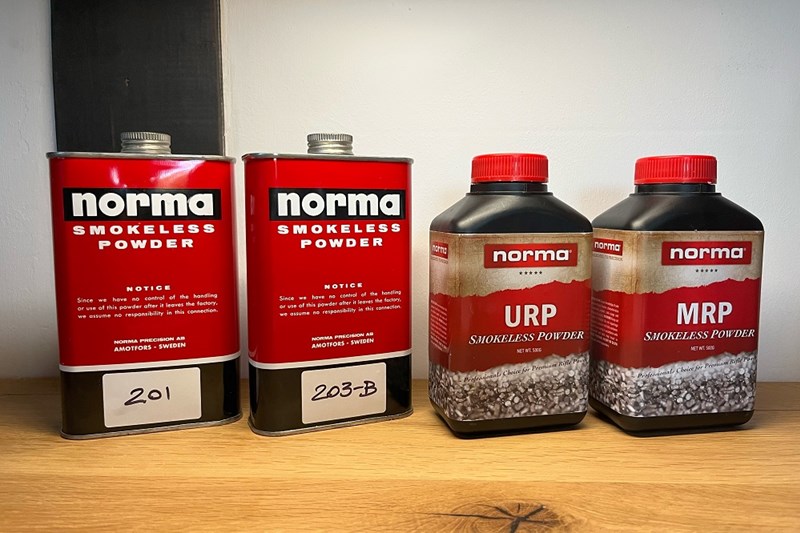
Remember to use the right powder. Work with only one at the time!
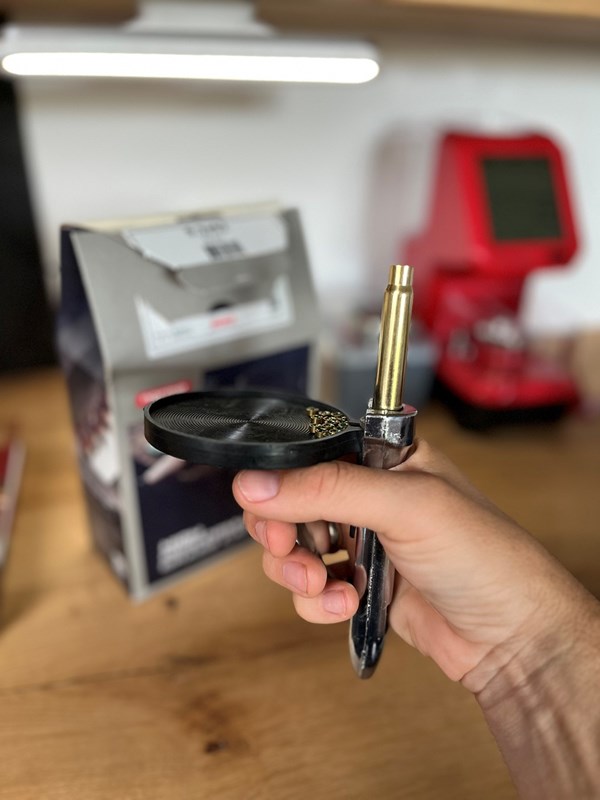
Primers have to be installed first obviously
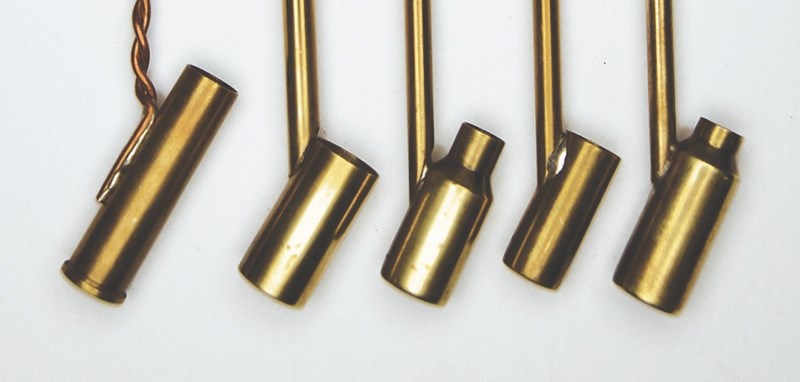
Fancy DIY "spoons" for taking quick powder loads
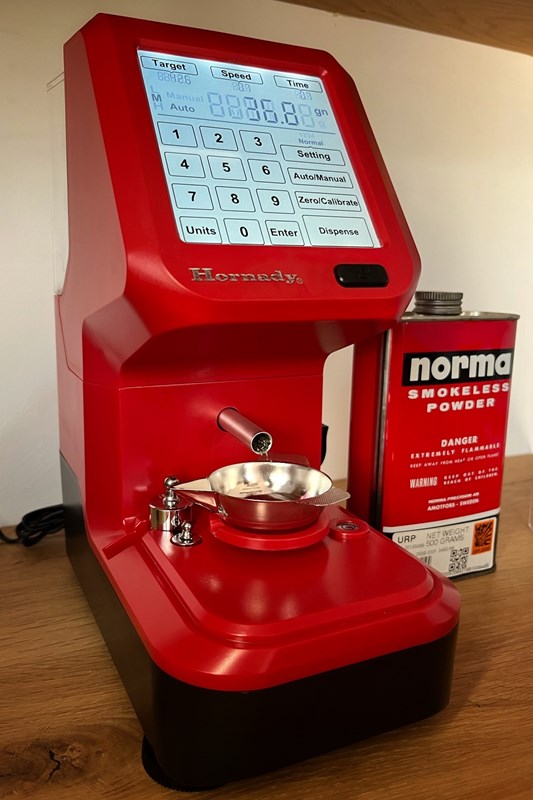
An automatic scale will stop pouring the powder on the pan once the charge will reached the desire target.
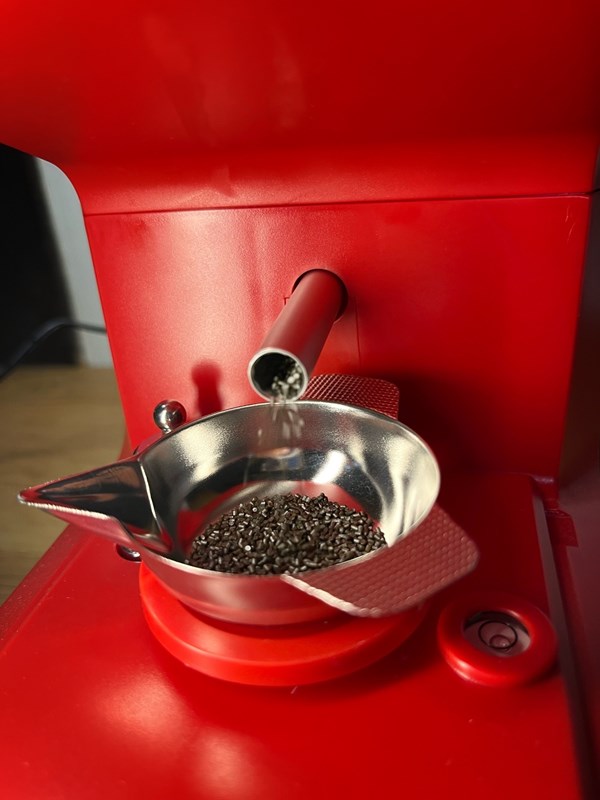
All scales should be leveled in order to provide the correct measurings.
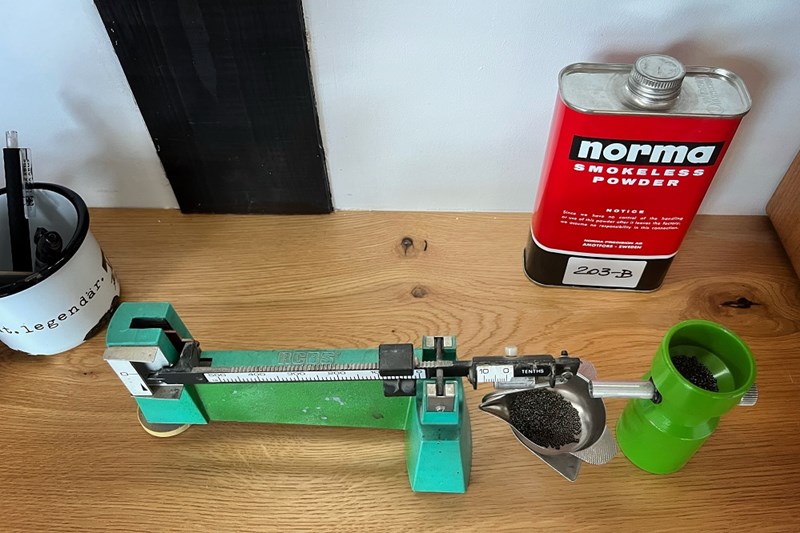
An oldschool scale and trickler is a slow but precise way to weigh the powder
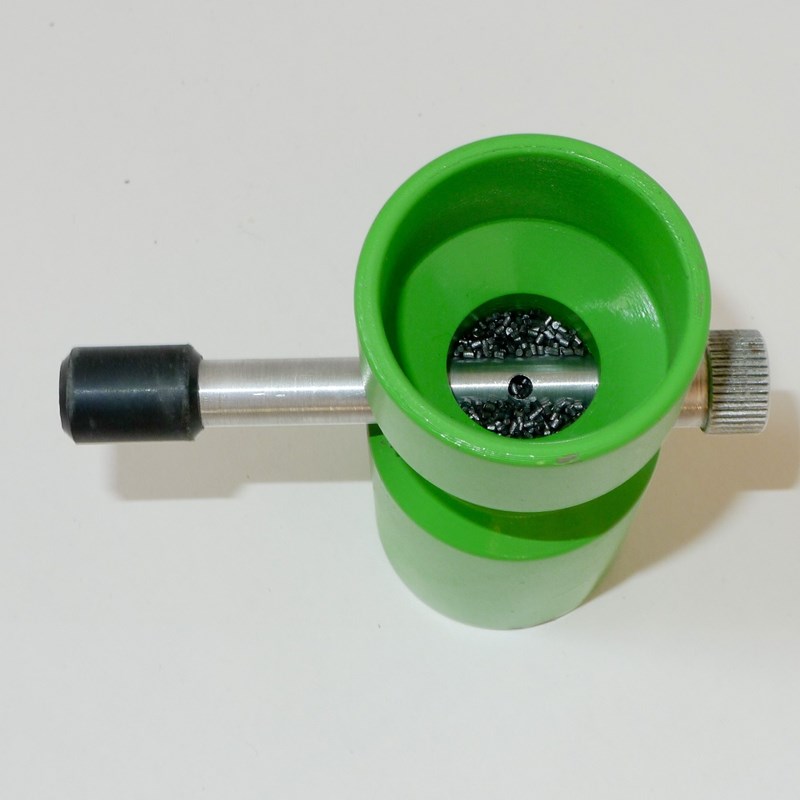
The trickler's pipe has a small hole, so it takes powder grain slowly. It is also threaded inside, so a rotation will move the grains forward.
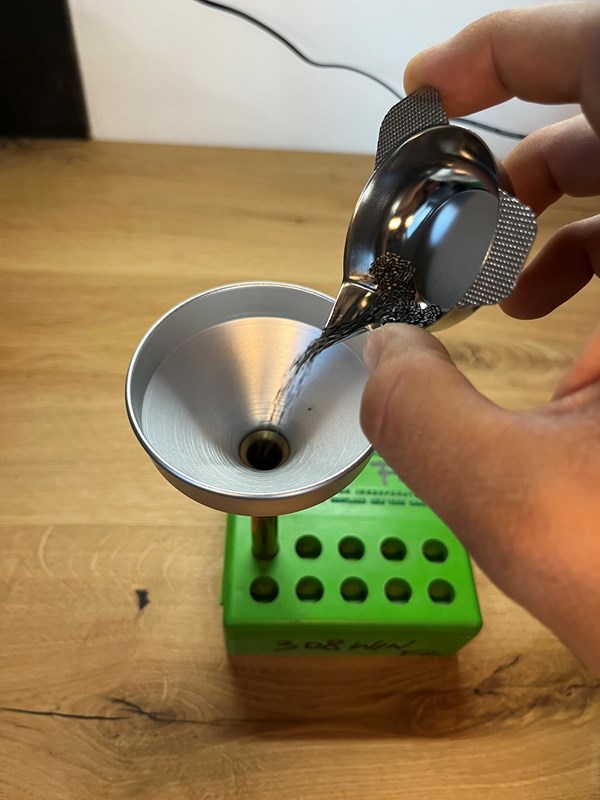
Fill the cases with care using apropriate funnel.
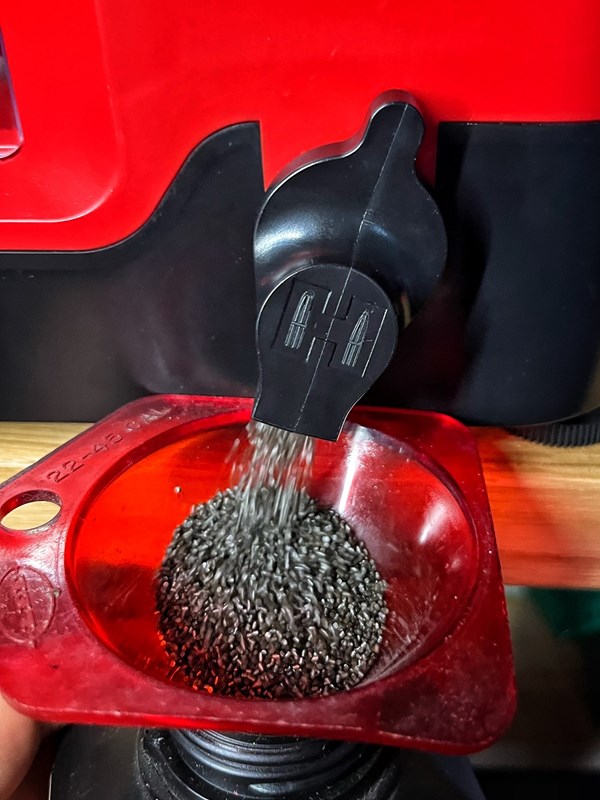
Remember to dump the powder after the work into the oryginal container in order to avoid later confusion!